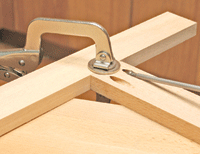
Summary
Pocket-hole joinery, or pocket-screw joinery, involves drilling a hole at an angle — usually 15 degrees — into one work piece, and then joining it to a second work piece with a self-tapping screw.

Pocket hole machines edit
Modern pocket hole machines are capable of routing low-angle pockets - as low as 3 degrees - creating more flush, stronger joints by minimizing the joint shift or “creep” that occurs when creating pockets and joints by using a pocket hole jig or by hand. Max Durney, founder of Castle USA, invented the very first pocket hole machine and was awarded the first pocket hole machine patent. Castle USA continues to manufacturer 3 degree and 6 degree pocket hole machinery at its headquarters in Petaluma, CA. [1]
Pocket hole jigs edit
Pocket holes can be formed by drilling a series of holes until a pocket hole is created, but pocket hole jigs make the process much quicker and easier. Pocket hole jigs allow the user to drill a hole at an accurate angle to get a good joint. Using a pocket hole jig also makes for a cleaner and neater appearance as opposed to creating a pocket hole without the help of a jig.[2] A pocket hole jig is generally made of plastic and has a metal insert that the drill bit is inserted through to drill the hole. A jig can be a stationary device that the wooden pieces are clamped into, or a portable device that is clamped onto the wooden pieces.[3]
Technique edit
When joining boards at a right angle, it is important that the cuts are precise and square to prevent gaps or un-perpendicular joints between the boards. Some woodworkers lay out their project before drilling their pocket holes and mark the face of the board that they want to drill to ensure the hole is in the correct location. Most pocket joints are made by screwing into the face or the edge of the board rather than the end grain because the screw will grab better.[4]
Pocket hole joint screws edit
Self-tapping pocket screws are used for pocket hole joints. Pocket screws are generally more expensive, but they are needed for a tight, strong joint. Pocket screws have a wide washer head to spread the load for a firm bond, and prevent screwing too far into the joint and cracking the wood. The self tapping screws will grip any type of wood, but coarse threads are needed for softer wood and fine threads are needed for harder.[5]
Pocket hole joint screws will vary in length depending on the thicknesses of the 2 pieces of material being joined. This is an important factor in correctly laying out a pocket hole joint, and a common cause for error.[6]
Benefits edit
- Because the screws act as internal clamps holding the joint together, glue is unnecessary (but usually recommended) for most common joints. If glue is used, clamping is not required because of the ‘internal clamps’ holding the joint together while the glue dries.
- Gluing and screwing the joints together prevents gaps from forming as wood shrinks and expands with temperature and moisture.
- Requires only one hole to be drilled, eliminating the need to precisely line up mating workpieces, as is required with dowel and mortise and tenon joints.
- Does not require any complex mathematics or measurements, such as those used in mortise and tenon joints.
- Because pocket-hole joinery doesn't require access to the inside of the joint, quick repairs are possible without completely disassembling the joint.
Drawbacks edit
- A broken pocket-hole joint "likely can’t be repaired".[7]
- Although the holes can be plugged the pocket hole may be considered unsightly when all sides of the joint are visible.
- It is not suitable for joining thin pieces of wood - 10-15mm minimum.
- Pocket-hole joints are substantially weaker than joints which use dowels, or mortises.[8]
Applications edit
-
-
-
-
-
-
-
Euro-style cabinets
-
-
-
Leg rails
-
-
-
References edit
- ^ "About Us". Castle USA. Retrieved 2021-04-16.
- ^ "No-jig Pocket-screw Joinery". WOOD Magazine. 2002-07-05. Retrieved 2018-12-14.
- ^ "Pocket Hole Joinery with the Kreg Jig". Rockler Woodworking and Hardware. Retrieved 2018-12-14.
- ^ "Pocket-hole pointers". WOOD Magazine. 2016-05-16. Retrieved 2018-12-14.
- ^ "How to Use Pocket Screws". The Family Handyman. Retrieved 2018-12-14.
- ^ Gharper (2021-11-25). "What size pocket hole screw should I use?". Tools and Tutorials. Retrieved 2021-12-08.
- ^ "The Anvil Test | Page 2 | Popular Woodworking Magazine". www.popularwoodworking.com. Retrieved 2018-12-14.
- ^ "Testing pocket holes against mortise and tenon and dowel joints". woodgears.ca. Retrieved 2023-05-21.


